 W
WAbactochromis is a monotypic genus of cichlid fish containing the single species Abactochromis labrosus. The genus name combines the Latin for "driven away from" with the commonly used haplochromine name "chromis". The name encompasses both the origin of the genus and the fish's solitary, wandering behaviour.
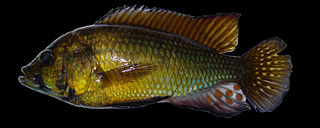 W
WAlluaud's haplo is a species of freshwater fish in the cichlid family, Cichlidae. It is native to East Africa, where it occurs in many lakes, including Lake Victoria.
 W
WAstatotilapia burtoni is a species of fish in the family Cichlidae.
 W
WAstatotilapia stappersii is a ray-finned fish species in the family Cichlidae. Adults measure about 15 cm (6 inches) in total length.
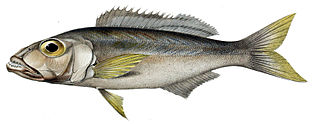 W
WBathybates ferox is a species of fish in the family Cichlidae. It is found in Burundi, the Democratic Republic of the Congo, Tanzania, and Zambia. Its natural habitat is Lake Tanganyika where it lives in shallow water and is exclusively piscivorous. The IUCN has assessed it as being a "least-concern species".
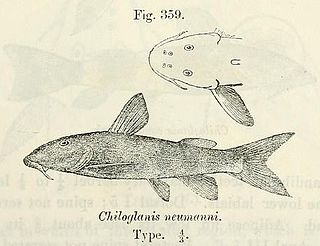 W
WChiloglanis neumanni, the Neumann's suckermouth, is a species of upside-down catfish native to Central Africa. This species grows to a length of 6.5 centimetres (2.6 in) SL.
 W
WThe coelacanths constitute a now-rare order of fish that includes two extant species in the genus Latimeria: the West Indian Ocean coelacanth primarily found near the Comoro Islands off the east coast of Africa and the Indonesian coelacanth. They follow the oldest-known living lineage of Sarcopterygii, which means they are more closely related to lungfish and tetrapods than to ray-finned fish. They are found along the coastline of Indonesia and in the Indian Ocean. The West Indian Ocean coelacanth is a critically endangered species.
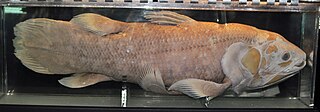 W
WThe West Indian Ocean coelacanth, sometimes known as gombessa, African coelacanth, or simply coelacanth, is one of two extant species of coelacanth, a rare order of vertebrates more closely related to lungfish and tetrapods than to the common ray-finned fishes. Latimeria chalumnae is a crossopterygian.
 W
WCyprichromis microlepidotus is an African species of fish in the family Cichlidae. It is endemic to Lake Tanganyika, where it is found in the northern part of the lake in Tanzania, Democratic Republic of the Congo, and Burundi.
 W
WDocimodus johnstoni is a species of haplochromine cichlid. It is known from Lake Malawi, Lake Malombe, and the upper Shire River in Malawi, Mozambique, and Tanzania. This species has unusual feeding habits: it is reported to feed on fins of clariid catfishes. The specific name honours the British explorer, botanist, linguist and Colonial administrator, Sir Henry Hamilton Johnston, who presented the type to the British Museum.
 W
WEleotris melanosoma, the broadhead sleeper or dusky sleeper, is a species of fish in the family Eleotridae native to marine, fresh, and brackish waters from coastal eastern Africa through southern Asia to the islands of the western Pacific Ocean. This species can reach a length of 26 cm (10 in). It is of minor importance to local commercial fisheries. This species has been introduced to the Panama Canal Zone.
 W
WEpinephelus spilotoceps, the foursaddle grouper or spotty cod,, is a species of marine ray-finned fish, a grouper from the subfamily Epinephelinae which is part of the family Serranidae, which also includes the anthias and sea basses. It is found in the Indo-Pacific region.
 W
WHaplochromis goldschmidti is a species of cichlid endemic to Lake Victoria, where it is only known to occur with certainty in the southern part of the Emin Pasha Gulf. It feeds mainly on zooplankton and some insects. This species can reach a length of 6.9 centimetres (2.7 in) SL. The specific name honours the Dutch evolutionary biologist Paul-Tijs (Tijs) Goldschmidt who he studied cichlids in Lake Victoria as a researcher from Leiden University.
 W
WHaplochromis guiarti is a species of cichlid endemic to Lake Victoria though it may now be extinct. This species can reach a length of 17.7 centimetres (7.0 in) SL. The specific name honours the French parasitologist Jules Guiart (1870-1965), who was a friend of Jacques Pellegrin's.
 W
WHaplochromis mento is a species of cichlid endemic to Lake Victoria. This species can reach a length of 17.8 centimetres (7.0 in) SL.
 W
WHaplochromis microdon is a species of cichlid endemic to Lake Victoria though it may now be extinct. This species can reach a length of 14.8 centimetres (5.8 in) SL.
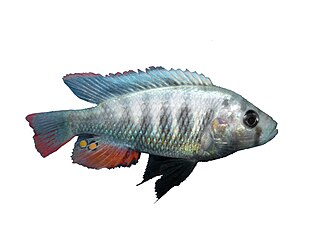 W
WHaplochromis pundamilia is a species of cichlid endemic to the Tanzanian portions of Lake Victoria. This species can reach a length of 12.4 centimetres (4.9 in) SL.
 W
WHaplochromis vonlinnei is a species of cichlid endemic to Lake Victoria. It is greyish in color with a distinct mid-lateral band, and a rather slender shape. It feeds mainly on smaller fish. This species can reach a length of 15.9 centimetres (6.3 in) SL. The population of the species has declined due to the introduction of the Nile perch in the 1950s. It has not been recorded since 1980 and the IUCN lists it as "Critically Endangered" and considers it may already be extinct. This fish is named in honour of the Swedish naturalist, Carl Linnaeus.
 W
WKneria uluguru is a species of fish in the family Kneriidae endemic to Tanzania. Its natural habitat is rivers.
 W
WLabeobarbus somereni, or Someren's barb, is a species of ray-finned fish in the family Cyprinidae. It is found in Burundi, Rwanda, Tanzania, and Uganda. Its natural habitat is rivers. It is not considered a threatened species by the IUCN. Local names for the fish in Rwanda include ikinanga, inkwenwe, ifurwe (Satinsyi) and urwozi (Nyabarongo).
 W
WThe Malawi squeaker is a species of upside-down catfish endemic to Lake Malawi. This species grows to a length of 19.2 centimetres (7.6 in) TL. This species is a minor component of local commercial fisheries and can also be found in the aquarium trade.
 W
WNeolamprologus is a genus of cichlids endemic to eastern Africa with all but one species, Neolamprologus devosi from the Malagarasi River, occurring in Lake Tanganyika. It is the largest genus of cichlids in Lake Tanganyika and also the largest genus in the tribe Lamprologini, which includes Altolamprologus, Chalinochromis, Julidochromis, Lamprologus, Lepidiolamprologus, Telmatochromis and Variabilichromis. The latter is a monotypic genus doubtfully distinct from Neolamprologus.
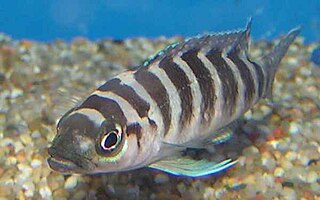 W
WNeolamprologus cylindricus is a species of cichlid endemic to Lake Tanganyika where it is only known to occur in the southeastern part of the lake. It prefers to live in recesses in the substrate and eats small benthic invertebrates. It lays its eggs in caves. It keeps close to the rocky bottom of the lake, mainly in depths less than 10 metres. This species can reach a length of 10.4 centimetres (4.1 in) TL. This species can also be found in the aquarium trade.
 W
WNeolamprologus mondabu is a species of cichlid endemic to Lake Tanganyika except for the southern portion where it is replaced by N. modestus. It prefers areas with rocky substrates, moving to areas with sandy substrates to breed. It feeds on the eggs of Lamprichthys tanganicanus. This species can reach a length of 10.7 centimetres (4.2 in) TL. This species can also be found in the aquarium trade.
 W
WNothobranchius kilomberoensis is a species of killifish in the family Nothobranchiidae. It is endemic to Tanzania where it is found in the floodplain of the Kilombero River where it is found in turbid, seasonal pools.
 W
WNothobranchius korthausae is a species of killifish in the family Nothobranchiidae.. It is endemic to Mafia Island in Tanzania. Its natural habitat is pools, ditches and small streams. The specific name of this species honours the German aquarist Edith Korthaus who collected the type.
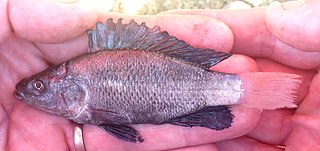 W
WOreochromis amphimelas is a species of tilapia cichlid endemic to north–central Tanzania, where it is found in Lake Manyara and a number of other saline lakes with closed basins. Maximum recorded size is 28 cm (11 in) in standard length.
 W
WPleurosicya mossambica, also known as the toothy goby or the Mozambique ghost goby, is a small species of goby native to the tropical Indo-West Pacific region. It was first described by South African ichthyologist J.L.B. Smith in 1959. Like many other gobies, it forms commensal relationships with several other marine invertebrates, including soft corals and sponges.
 W
WSynodontis grandiops is a species of upside-down catfish endemic to the Democratic Republic of the Congo, Burundi, and Tanzania, where it is only known from Lake Tanganyika. It was first described by Jeremy John Wright and Lawrence M. Page in 2006, from specimens collected at multiple points along the shore of Lake Tanganyika. The species name is a Latinized combination of the Latin "grandi", meaning large or big, and the Greek "ops", meaning eye, a reference to the relatively large eyes of this fish.
 W
WSynodontis granulosus is a species of upside-down catfish endemic to the Democratic Republic of the Congo, Burundi, Zambia, and Tanzania, where it is only known from Lake Tanganyika. It was first described by Belgian-British zoologist George Albert Boulenger in 1900, from specimens collected at multiple points along the shore of Lake Tanganyika. The species name comes from the Latin word "granulum", meaning of grain, and refers to the granular papillae present on the skin of the fish's body.
 W
WSynodontis melanostictus is a species of upside-down catfish endemic to Lake Tanganyika and its tributaries. It has been found in Zambia, the Democratic Republic of the Congo, and Burundi. It was first described by British-Belgian zoologist George Albert Boulenger in 1906, based upon a specimen from the Lofubu River. The species name "melanostictus" is derived from a combination of the Greek melano, meaning black, and the Greek stiktos, meaning punctured or spotted. This refers to the black spotted pattern that occurs on the body of this species.
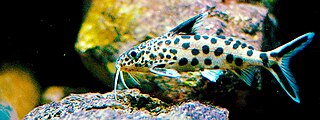 W
WSynodontis multipunctatus, also known as the cuckoo catfish, cuckoo squeaker, or multipunk, is a small catfish from Lake Tanganyika, one of the lakes in the Great Rift Valley system in Africa. It is a brood parasite upon mouthbrooding cichlids. This species grows to a length of 27.5 centimetres (10.8 in) TL. This species is a minor component of local commercial fisheries.
 W
WSynodontis petricola, known as the cuckoo catfish, or the pygmy leopard catfish, is a species of upside-down catfish endemic to Burundi, Zambia, the Democratic Republic of the Congo, and Tanzania where it is only known from Lake Tanganyika. It was first described by Belgian ichthyologist Hubert Matthes in 1959. The species name "petricola" is derived from a combination of the Latin petra, meaning stone or rock, and the Latin cola, meaning inhabitant. This refers to the rocky environment where this species is found.
 W
WSynodontis zambezensis, known as the brown squeaker, the korokoro, or the plain squeaker, is a species of upside-down catfish that is native to the middle and lower Zambezi River system of Mozambique, South Africa, Swaziland, Tanzania, Zambia and Zimbabwe. It was first described by German naturalist and explorer Wilhelm Peters in 1852, from specimens collected in the Zambezi River in Mozambique. The species name zambezensis is derived from the Zambezi River, where this species is found.
 W
WWerner's catfish is a species of airbreathing catfish. It is found in Burundi and Tanzania. Its natural habitats are rivers and freshwater lakes. It is threatened by habitat loss. This species reaches a length of 23.0 cm SL.
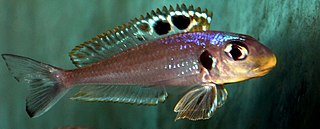 W
WXenotilapia bathyphila is a species of cichlid endemic to Lake Tanganyika where it occurs in schools in areas with sandy substrates. It feeds on small shrimps and copepods. This species can reach a length of 10.3 centimetres (4.1 in) TL. It can also be found in the aquarium trade.